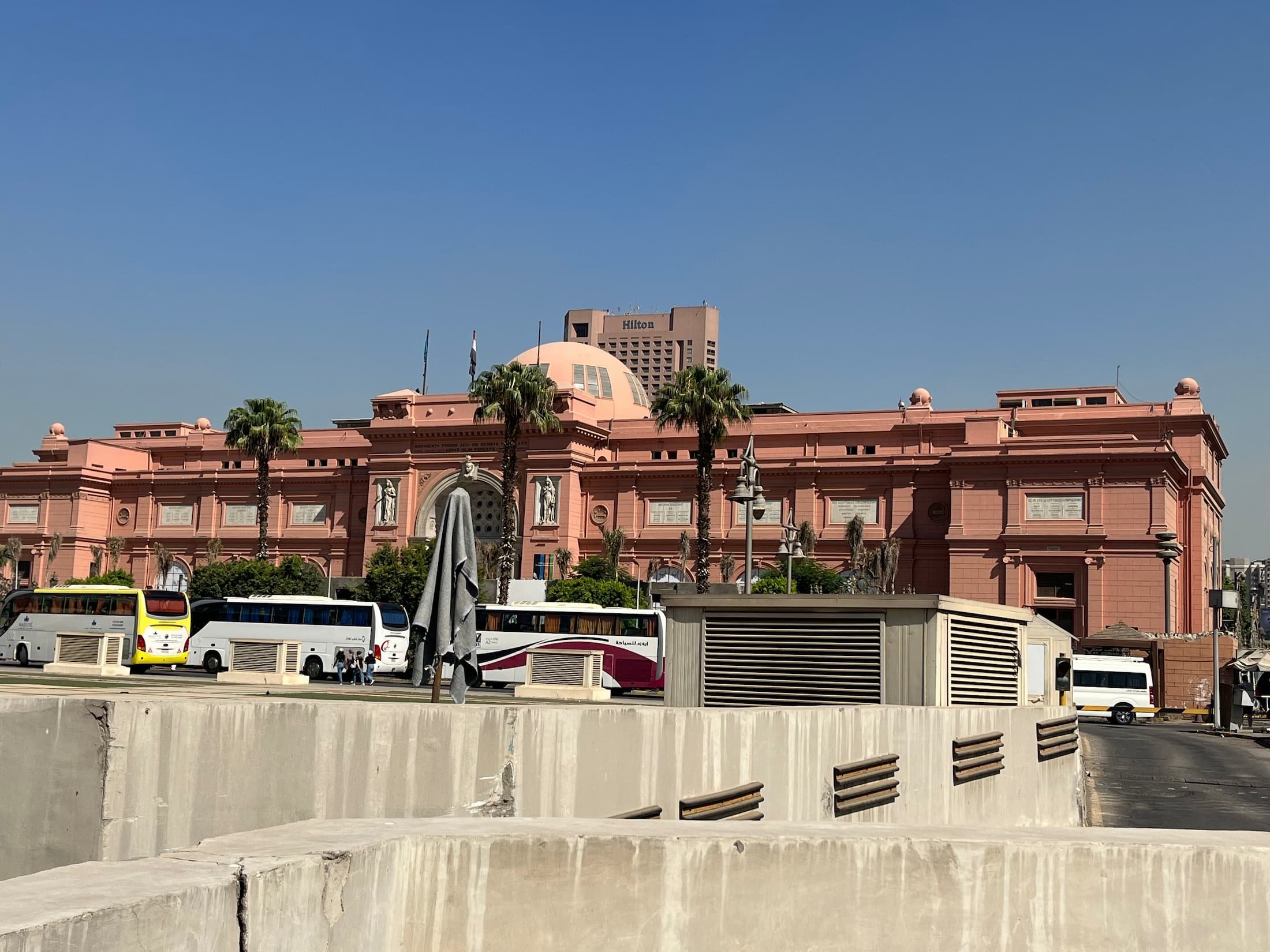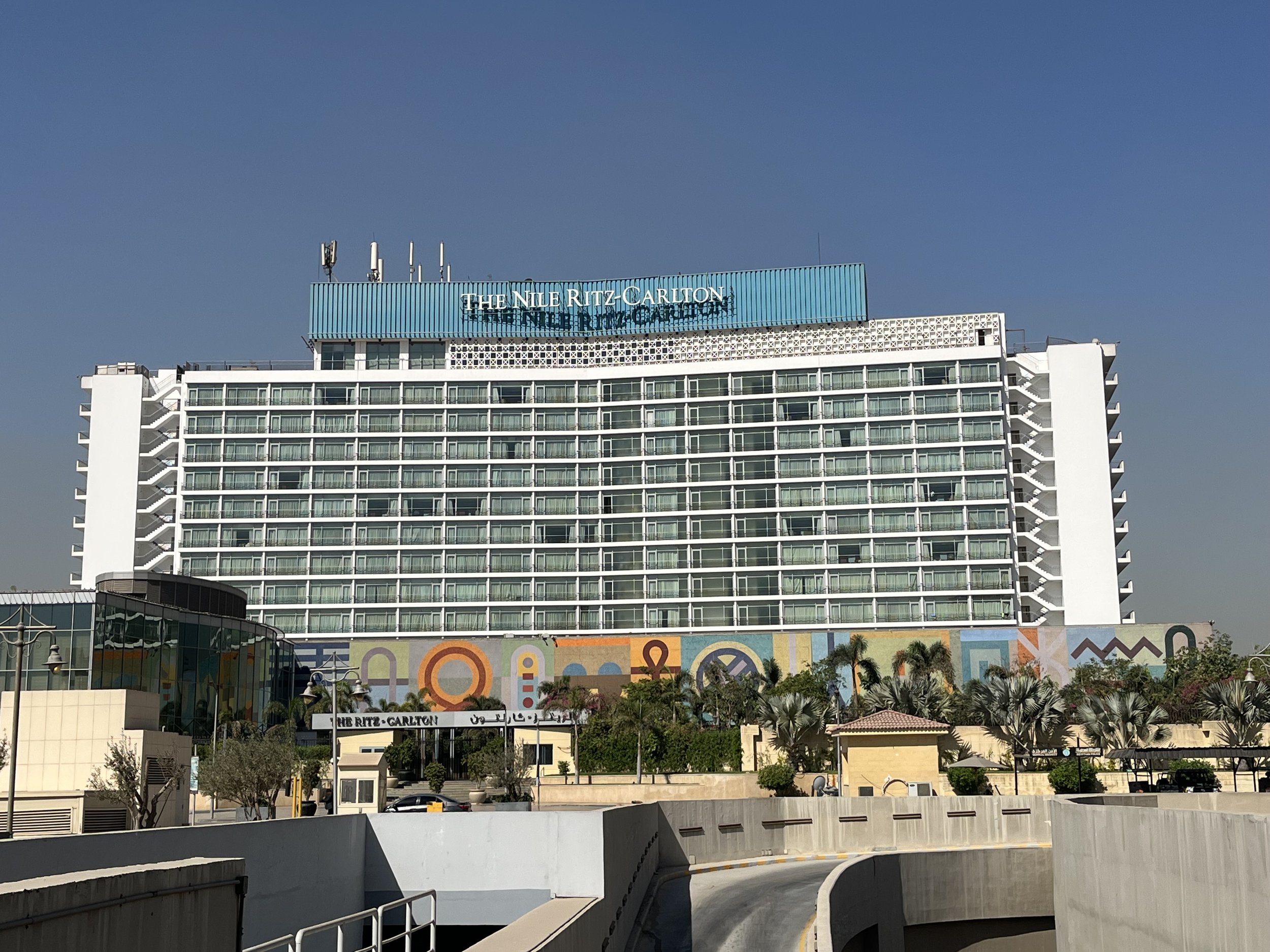A morning visit to the Egyptian Museum of Antiquities in Cairo.
Despite visiting first thing in the morning, the museum was boiling, and very loud!
However, getting up close to some of ancient Egypt’s finest treasures made it all worthwhile.
And seeing the famous death mask which Tutankhamun was discovered wearing was incredible!
Visiting Cairo soon?
The Egyptian Museum of Antiquities should be a must on your itinerary, and this blog details what you can expect from the century old building, which showcases ancient Egypt.
Even though the Grand Museum in Cairo will soon be opening, this original museum should still be visited, as it is the world’s largest museum of ancient art.
With over 120,000 artefacts, you need to know how to navigate the famous site.
Let’s start with the practical information for your visit.
Posing next to a cool statue.
How can you visit the Egyptian Museum of Antiquities?
The Egyptian Museum is located right in the heart of Tahrir Square in Cairo, which is famous for its turbulent history, and the 2011 Egyptian revolution.
As an International tourist, you are allowed to enter the Egyptian Museum on your own, or with an official tour group.
You just need to purchase a ticket at the ticket office on site when you arrive, or online prior to your visit.
After passing through a security scanner and checkpoint, you are free to enter and explore at your own leisure.
How to reach the Egyptian Museum.
It is easy to reach Tahrir Square in Cairo, as there are many different transport options available to you on your Cairo city break.
Here are your options:
Taxi.
Taxis are a convenient option throughout the city and can be flagged down on the side of the road, or can be pre-booked. I found that this option is risky, and found that I was overcharged on some journeys, as I did not agree to a fixed price before I entered, along with experiencing a small language barrier.
You can mitigate these issues by asking your hotel to pre-book a taxi for you.
Uber.
Uber is available in Cairo and I found it to be the best way to traverse the capital. The real time tracking and fixed costs offer some reliability and reduced stress for your journeys.
Metro.
A Metro service operates in Cairo, so is a viable option for budget travellers. The closest station to the museum is ‘Sadat’, which is only around 500 metres away. A little further out is the station called ‘Attaba’, at around 1.5km away.
Tickets can be purchased in the various stations around the city.
Walking.
If you stay in and around Tahrir Square, then the museum is reachable by foot, depending on the month you visit. In September, I walked to many spots in the city from the square, and had no issues.
Summer months will make this a lot more difficult.
The century old building.
Practical information for visiting the Egyptian Museum.
Opening hours:
9am - 5pm everyday.
Entrance fees:
Adults - 300 EGP (£5).
You can only purchase tickets by card.
The ticket office is located just outside the museum.
My ticket.
My experience exploring the Museum.
On my solo Egypt trip, I started in Cairo and stayed in Tahrir Square, so I made sure the Egyptian Museum was the first activity on my itinerary, as it is one of the best things to do in Egypt.
I visited right on opening time and still had to queue for a short while to purchase my ticket from the ticket office after passing the security checks.
After a short while I entered the grand museum, and my first impressions were that of confusion.
I found it to be poorly signposted, and a wall of white noise hit my ears immediately, from all of the different tours which were wandering around the exhibitions near the entrance.
The guides were having to shout to be heard in that area, although some of them shout for added effect on the stories they are telling from the ancient past!
My ticket covered all areas of the museum, including King Tut’s room.
Many of the exhibits are labelled in English, Arabic, and French, which ensured that I learned some interesting facts about ancient Egypt without a tour guide.
One thing which you should be cautious of, as with all of the famous sites in Egypt, are the locals offering to ‘take your picture’, or ‘show you a secret room’.
These are just scams, so ignore any suspecting behaviour from your surroundings.
There are queues for Tutankhamun’s room, so it is a good idea to head upstairs straight away if you are visiting first thing in the morning.
This will keep you away from most of the crowds for the start of your exploration.
I spent around 45 minutes on each floor, reading the exhibits, taking photos and taking in the history.
A grand entrance.
The Ground floor of the Museum.
I found the ground floor to be home to the larger relics from ancient times, including some giant statues, full size sarcophaguses, and original walls covered in hieroglyphics and art.
One thing that was a surprise was how close you can get to all the artefacts.
I found there to be more protection for the relics in museums in Luxor and Aswan.
Stone in the Old Kingdom.
As the Old Kingdom came around, the ancient Egyptians introduced mass use of stone to the arts and architecture, as it helped them to build iconic structures which can stand the test of time.
You can see that they were correct, as many of the stone relics on the ground floor of the museum have survived thousands of years remarkably well.
I was reading that the stone era was marked by the reign of Djoser, who also built the first stone pyramid in the world at Saqqara.
The Main Exhibition Hall.
Some famous artefacts on site.
There is such a variety of ancient relics on display that I could write a dissertation about them, just on the ground floor!
Here are some of the treasures which await you on site:
Wall reliefs.
There are some wall reliefs covered in art which depict ancient Egyptian beliefs.
My favourite one displayed vibrantly coloured pictures of an Ibis and Baboon headed deity offering gifts to Egyptian gods.
I noticed similar wall reliefs in different spots in Cairo, which looked a little more modern.
My favourite wall relief.
Pyramid statues.
I noticed several pyramid statues in black, which were inscribed with original hieroglyphic carvings, and although damaged, they showcase the ancient Egyptians’ love of pyramids.
I also noticed a similar statue at Ramses Train Station when I went to catch the night train to Luxor, and many smaller replica versions at Khan El-Khalili, and Luxor Market.
One of the many pyramid statues.
A giant colossi - A Pharaoh and his Queen.
The centrepiece of the main exhibition hall is a giant colossal statue, which is said to be of ‘Amenhotep III’ and ‘Queen Tiye’.
It is over 3000 years old and was discovered in the city of Luxor.
The impressive statue was once located in Medinet Habu Temple, which was my favourite West Bank Temple during my visit to Luxor.
The sheer scale of the stone structure reminds me of some of the statues at Karnak Temple and Luxor Temple, along with the Colossi of Memnon in Luxor.
You can enjoy awesome views of the statue from both floors, depending on which perspective you want.
A Pharaoh and his Queen.
A stone sarcophagus.
A stone statue.
The first floor of the Museum.
Upstairs in the museum, there are many rooms offering different relics from the final two dynasties of ancient Egypt.
I noticed a lot of items from the tombs of famous pharaohs, such as Thutmosis III, Thutmosis IV, and Amenophis II, along with famous priests and the higher echelon of the ancient civilisations.
A famous mummy on site.
The mummy of one of the most famous queens from ancient Egypt is located on site.
Queen Hatshepsut ruled between 1507 BCE - 1458 BCE and attained unprecedented power for a female ruler.
I got this impression as I wandered around the Temple of Hatshepsut in Luxor, as its architecture is so grand and elegant, although it is damaged considerably in today’s world.
Other original mummies in the museum include ‘Yuha’ and ‘Thuya’.
Awesome views of the main exhibition hall.
Do you need a tour guide in the Egyptian Museum?
The museum is over a century old, so it is dated and this shows both inside and outside of the building.
With the new museums opening on the horizon, the Egyptian Museum has suffered some neglect, therefore, artefacts and exhibits aren’t ordered neatly, and many are missing detailed information.
Visiting on an official tour ensures that you can gather all the important information from each section of the museum, to piece together a better understanding of ancient Egypt.
I noticed that the tour groups were shown around the museum in chronological order, making it easier to follow the pharaonic journey through the many dynasties.
I personally enjoyed the opportunity of exploring on my own to use my imagination more.
Birdseye view of the giant statue.
A room dedicated to Tutankhamun.
The highlight for many visitors to the museum is the special room dedicated to King Tut, one of the most famous pharaohs from ancient Egypt.
During my childhood I learned a lot about Tutankhamun, and how he was discovered by Howard Carter in his tomb, full of treasure, so coming face to face with his death mask was surreal.
Unfortunately I didn’t capture the perfect Egyptian Instagram shot, as photos are not permitted to be taken in his room.
You also have to queue to enter, so an early morning visit will reduce your waiting time.
His room offers some peace and quiet compared to the rest of the museum, and is home to original jewels, his death mask, and other items from his tomb.
I found it awesome that my childhood stories finally came to reality.
Especially knowing I was to meet his mummy in Luxor later in my Egypt adventure.
Information board for King Tut’s room.
When is the best time to visit the Egyptian Museum?
Whichever time of the year you visit Cairo, the museum will be packed as the capital is a popular city for tourists, all wanting to learn about Egypt’s fascinating past.
In peak season, you will enjoy cooler temperatures, which helps massively, as there is no air con in most rooms of the museum, however, the crowds are far greater.
You could be queuing to enter King Tut’s room for a while!
I visited in September (shoulder season), so enjoyed fewer crowds, but warm and stuffy conditions inside.
From my personal experience, an early morning visit is essential.
I visited just after opening time, and there were still large tour groups taking up large spaces of the exhibition hall.
If you stay nearby, it is easier to add the Museum to your early morning plans.
Stone statues everywhere.
How long is needed to explore the Egyptian Museum?
The answer here can vary considerably, depending on your level of interest in ancient Egypt, group size, and Egypt itinerary.
Wandering around on my own, I managed to explore the whole museum in around 90 minutes, however, I didn’t learn about every artefact in detail.
If you want to learn about every area of the museum and take a detailed interest in every exhibit, there are enough artefacts to spend all day on site.
This would include a break for refreshments throughout the day!
Egyptology enthusiasts might want multiple visits to delve deeper into some specific exhibits on display.
A guided tour can help you see the most important exhibits and learn more about them from a knowledgeable guide.
This is a good option if you're short on time and want to see the most important parts of the museum.
More wall reliefs.
Where to stay near the Egyptian Museum?
Visiting the Pyramids of Giza is one of the main reasons why tourists visit Cairo, and the hotels in and around Tahrir Square all offer a central location with good transport options.
Most of the budget tours offer pick ups from the accommodation in Tahrir Square.
Here is a recommendation for different budget levels.
Budget.
Heritage Hostel Cairo - Located 400m from the Egyptian Museum, and offers continental breakfast included in price. A really cheap option if you are backpacking, or don’t plan to stay in your room much.
Mid-range.
Museum Plaza - Situated opposite the Museum, this hotel offers a comfortable stay in a very convenient location.
Luxurious.
The Nile Ritz-Carlton, Cairo - A fabulous option offering a luxurious stay right in the heart of the city. Walking distance to the Egyptian Museum, and only 1km from the famous Khan El-Khalili market.
An awesome hotel close to the museum.
When is the Grand Egyptian Museum opening?
The Grand Egyptian Museum (GEM) near Giza, Egypt is currently open for limited trial visits to certain completed areas.
However, there hasn't yet been an official announcement for its full public opening.
Many sources, including news articles and third-party websites documenting the museum's progress, estimated a late spring 2024 opening.
The Gift shop and restaurant on site.
On your way out of the museum you will exit through a large gift shop, which ironically sells the tour guide booklets.
I also noticed many good quality books about the Museum and other parts of ancient Egypt, across several languages.
In my opinion, these should be either given for free, or sold at the entrance point!
There is also a cafe/restaurant located outdoors as you leave the site.
This was the only place in the museum which sells cold drinks, which I didn’t find out until I was leaving. It is thirsty work exploring all of the artefacts, so make sure you take a drink with you, or be prepared to leave and re-enter (I think this is allowed with your ticket).
A large gift ship located at the exit point.
Another two awesome museums to consider on your Egypt trip.
There is no doubt that the Egyptian Museum in Cairo is spectacular, and was one of the highlights of my 8 day Egypt itinerary, however, there are smaller museums which offer a more relaxing experience.
In Luxor, the museums are a popular escape from the heat of exploring the city’s archaeological sites such as the tombs and famous temples.
The Mummification Museum was my favourite, as it had immaculate vibes throughout!
Despite it being small in size, it is ordered neatly, and the exhibitions all display detailed information in English.
There are more original mummies in this museum also!
If you are heading south to Aswan, then you will be introduced to the Nubian culture, which dates back thousands of years. The local Nubians thrive in Aswan, across the city, and in the different Nubian villages.
The Nubian Museum should be a priority during your trip to Aswan, so you can learn about the fascinating history behind the smiling faces which will light up your trip.
Its Nubian aspect makes Aswan a very popular destination.
Disclosure: I sometimes use affiliate marketing. This will not cost you anything, but helps with my travel costs. I only recommend companies I use myself.




















